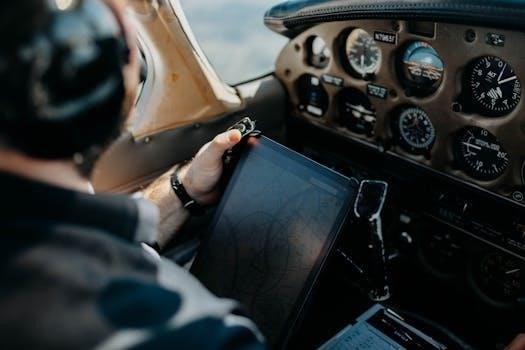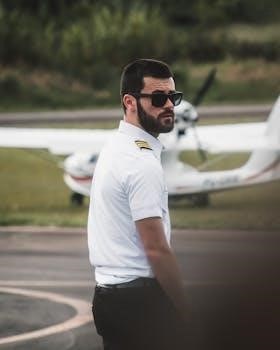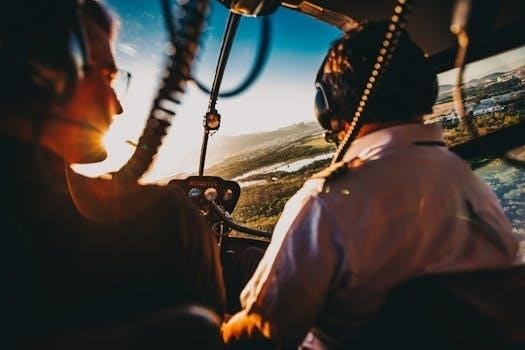
Overview of Professional Pilot Training
Professional pilot training is a rigorous process, combining theoretical knowledge with practical flight experience․ It involves structured syllabi, including ground school and flight training, preparing individuals for a career in aviation․ The training adheres to FAA standards, emphasizing competency and safety․ A comprehensive approach ensures pilots are well-prepared for the demands of professional flying․
The Importance of a Structured Syllabus
A structured syllabus is paramount in professional pilot training, providing a roadmap for both students and instructors․ It ensures all required topics are covered, from aviation principles to meteorology, in a logical and efficient manner․ A well-defined syllabus integrates ground and flight lessons, creating a cohesive learning experience․ This approach allows for a better understanding of complex concepts, linking theoretical knowledge to practical application in the cockpit․ A structured syllabus facilitates consistent training, ensuring all students receive the same high standard of instruction․ The syllabus also includes stage exams to assess progress․ It aligns with FAA requirements, preparing students for certification․ Furthermore, a syllabus promotes efficient learning, maximizing the use of training resources․ It also offers a clear framework for tracking progress and identifying areas needing improvement․ A structured syllabus provides the backbone of effective pilot training, ensuring future pilots are competent and safe․ It also allows for flexibility and adaptability, meeting individual student needs while maintaining standards․ A comprehensive and organized syllabus is essential for successful pilot training outcomes․

Understanding Pilot Licensing
Pilot licensing progresses through stages, starting with the Student Pilot License (SPL)․ This is followed by the Private Pilot License (PPL), and then the Commercial Pilot License (CPL)․ Each license grants increasing privileges, with the CPL needed for professional flying․
Student Pilot License (SPL)
The Student Pilot License (SPL) is the initial step in becoming a pilot, marking the beginning of your flight training journey․ Obtaining an SPL requires meeting certain age and medical requirements, as well as demonstrating basic understanding of aviation rules and regulations․ The SPL allows you to begin flight training with a certified flight instructor․ It’s crucial to understand that while holding an SPL, you cannot act as pilot in command or carry passengers; This license is primarily for learning purposes, enabling you to log flight hours and gain essential experience․ The SPL is a fundamental step, setting the stage for further pilot certifications․ It signifies your commitment to aviation and allows you to take the first steps towards achieving your goal of becoming a pilot․ This initial license lays the groundwork for more advanced training and licenses, such as the Private Pilot License (PPL)․ The SPL ensures a safe and structured learning environment for aspiring pilots․
Private Pilot License (PPL)
The Private Pilot License (PPL) allows you to fly for personal use, carrying passengers, but not for compensation or hire․ Obtaining a PPL requires completing ground school, passing both a knowledge test and a practical flight exam; The PPL training syllabus includes diverse topics like aerodynamics, meteorology, navigation, and aircraft systems․ You’ll learn to handle basic flight maneuvers, emergency procedures, and cross-country flights․ The PPL provides a solid foundation for more advanced pilot licenses․ It also allows you to experience the joy of flying and share it with friends and family․ The PPL is a significant milestone in your pilot career, signifying a high level of skill and knowledge․ It enables you to explore the freedom of flight within the limitations of private operations․ The PPL is a gateway to further training and specialization, such as instrument ratings or commercial licenses․ It demonstrates your commitment to aviation and your capability to operate an aircraft safely and competently․
Commercial Pilot License (CPL)
The Commercial Pilot License (CPL) is a significant step for aspiring professional pilots, allowing you to fly for compensation or hire․ Unlike the Private Pilot License, the CPL requires a higher level of proficiency and knowledge․ The CPL training syllabus includes advanced flight maneuvers, complex aircraft systems, and more detailed regulations․ You will learn to operate aircraft in various conditions, including night flights and adverse weather․ The CPL training program includes rigorous ground school instruction, covering topics like aerodynamics, meteorology, and navigation․ The flight training component focuses on advanced skills and commercial operations․ You must pass both a knowledge test and a practical flight exam to obtain the CPL․ This license opens doors to various aviation careers, such as airline pilot, charter pilot, and flight instructor․ The CPL demonstrates your ability to operate an aircraft safely and professionally, meeting the demands of commercial aviation․ Obtaining the CPL is a challenging but rewarding endeavor for those passionate about flying․
Key Components of Pilot Training
Pilot training is comprised of two essential elements⁚ ground school, which covers theoretical knowledge, and flight training, which focuses on practical skills․ These components work together to prepare pilots for safe and proficient flight operations, meeting all regulatory requirements․
Ground School Curriculum
The ground school curriculum is a vital part of pilot training, providing the essential theoretical foundation needed for safe and proficient flying․ This curriculum covers a wide range of topics, including aviation principles, aerodynamics, meteorology, and navigation․ Students must grasp these concepts to pass FAA knowledge tests and understand the intricacies of flight․ Ground school also delves into regulations, aircraft systems, and emergency procedures․ This comprehensive training ensures pilots are well-versed in both the technical and regulatory aspects of aviation․ The curriculum is often integrated with flight lessons, creating a cohesive learning experience․ Through classroom instruction, pre-flight briefings, and post-flight discussions, students are prepared for the challenges of flight․ The ground school curriculum is designed to provide a thorough understanding of aviation concepts, which is crucial for success in both flight training and future pilot careers․ The FAA reviews these syllabi to ensure they meet all requirements, offering a fresh and comprehensive approach to learning․
Flight Training Curriculum
The flight training curriculum provides the practical skills necessary to become a competent pilot․ This hands-on component of pilot training is where students learn to apply the knowledge gained in ground school, under the guidance of certified flight instructors․ The curriculum typically begins with basic maneuvers, such as takeoffs, landings, and straight-and-level flight, gradually progressing to more complex procedures․ Students learn to operate the aircraft safely and efficiently in various conditions, including cross-country flights and emergency situations․ The flight training syllabus is designed to integrate with the ground school curriculum, creating a comprehensive learning experience․ It includes dual instruction, where the student flies with an instructor, and solo flights, where the student operates the aircraft independently․ Progress is evaluated through stage checks and practical exams, ensuring that students meet the required standards․ The curriculum emphasizes competency-based training, allowing students to advance at their own pace as they master each skill, ultimately preparing them for their check ride and future flying endeavors․ Flight training also includes learning about risk management, threat and error management, and energy management․

Syllabus Content & Features
A professional pilot training syllabus incorporates FAA compliance, integrating ground and flight lessons․ It uses a competency-based approach, providing a structured, comprehensive, and efficient program․ The syllabus includes stage exams and additional resources for thorough training․
FAA Compliance and Standards
The Federal Aviation Administration (FAA) sets the standards for all pilot training programs in the United States․ A syllabus must adhere to these regulations, ensuring that all training meets the required safety and proficiency levels․ Compliance with FAA regulations is paramount for any pilot training program․ This includes meeting specific requirements for both ground school curriculum and flight instruction, designed to produce competent and safe pilots․ The syllabus is often reviewed by the FAA to ensure that it meets current standards and incorporates any changes in regulations․ This rigorous oversight helps maintain the integrity of the training and ensures that all pilots meet a consistent standard of skill and knowledge․ The syllabus details how each element of training addresses these FAA requirements․ It also ensures that students receive the necessary knowledge to pass their written and practical exams․ Furthermore, adherence to FAA standards guarantees a smooth transition for pilots to further advanced training and licensing․
Integration of Ground and Flight Lessons
A crucial aspect of effective pilot training is the seamless integration of ground school curriculum and flight instruction․ A well-designed syllabus ensures that theoretical knowledge gained in the classroom is directly applied during practical flight training․ This means that topics discussed in ground school are reinforced by practical experiences in the aircraft․ This approach helps students grasp concepts more effectively, enhancing both understanding and skill․ The syllabus often presents flight lessons side-by-side with coordinating ground lessons, creating a cohesive learning experience․ This method ensures that theory and practice complement each other, allowing for a deeper comprehension of aviation principles․ The integration is designed to facilitate a practical understanding of aviation concepts, making learning more engaging and efficient․ By combining ground and flight elements, students build a strong foundation of both knowledge and practical application․ This synchronized approach maximizes learning and promotes a complete understanding of the material․
Competency-Based Training Approach
A competency-based training approach is a modern method gaining traction in pilot education; This approach shifts the focus from time-based training to achieving specific performance standards․ It emphasizes that students should demonstrate mastery of skills and knowledge rather than simply completing a set number of hours․ The syllabus focuses on what a student can do, not just what they have studied․ This method requires that students are assessed on their ability to perform required tasks safely and efficiently․ This approach ensures that pilots are truly competent before advancing to the next stage of training․ It also helps to ensure that each student receives the training they need to achieve a higher level of expertise․ The competency-based approach allows for more individualized training, where students can progress at their own pace․ The focus remains on the student’s ability to demonstrate a particular proficiency, rather than the time spent in training․ This approach is designed to create safer and more skilled pilots․

Advanced Training and Specializations
After obtaining a commercial pilot license, pilots can pursue advanced training such as multi-engine ratings and type ratings․ These specializations enhance career opportunities and allow pilots to operate more complex aircraft, providing additional skills and qualifications in the aviation field․
Multi-Engine Rating
A multi-engine rating allows pilots to operate aircraft with more than one engine, expanding their operational capabilities and career prospects․ This rating involves specialized training focused on the unique aspects of multi-engine aircraft, such as engine-out procedures and asymmetric thrust management․ The curriculum includes both ground school and flight instruction, covering topics like aerodynamics, systems, and emergency procedures specific to multi-engine operations․ Pilots must demonstrate proficiency in handling these aircraft safely and effectively․ Obtaining a multi-engine rating is often a necessary step for pilots seeking employment with airlines or other commercial operators that utilize multi-engine aircraft․ It builds upon the foundational skills learned during single-engine training and introduces new challenges and responsibilities associated with operating more complex aircraft․ This rating increases the pilot’s versatility and opens doors to a wider range of flying opportunities․ Training includes intensive practice on engine failure scenarios, which are critical for safe multi-engine operations․ Successful completion of the multi-engine rating significantly enhances a pilot’s qualifications and marketability in the aviation industry․ The course emphasizes both theoretical knowledge and practical skills necessary for safe and efficient multi-engine flying․
Type Rating
A type rating is a specific authorization required for pilots to fly particular types of aircraft, typically large, complex, or high-performance models․ This rating focuses on the unique operational characteristics and systems of a specific aircraft, going beyond the general knowledge of multi-engine or other basic ratings․ Training involves in-depth study of the aircraft’s manuals, procedures, and limitations, along with extensive simulator and flight instruction․ Pilots learn about the aircraft’s specific handling qualities, emergency procedures, and avionics․ The type rating is designed to ensure pilots are thoroughly proficient in operating a particular model of aircraft safely and effectively․ Achieving a type rating often involves rigorous testing and evaluation by the relevant aviation authority․ This certification is crucial for pilots aiming to fly commercial airliners, business jets, or other advanced aircraft․ The syllabus incorporates both theoretical and practical elements, ensuring a comprehensive understanding of the aircraft’s design and operational procedures․ Type ratings are essential for maintaining the highest standards of safety and efficiency in aviation․ The process demands a high level of attention to detail and a strong commitment to continuous learning and proficiency․ Successful completion allows a pilot to operate the specific aircraft type with confidence and competence․ This advanced training is a vital component of a professional pilot’s development, allowing them to operate a broader range of aircraft․
